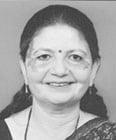
Head of the Department of Herbal Medicine at the NIA
Dr. Mita Kotecha MD (Ayu) PhD (Ayu) is Professor and Head of the Dravyaguna Department at the National Institute of Ayurveda (NIA) in Jaipur. Her professional career is dedicated to herbal medicine, which she has been teaching in a leading position since 1991. Dr. Kotecha is also Chairman and member of a number of committees including AYUSH, NIA and Rajasthan Ayurveda University.
Ayurveda is the science of life, a system of health care and medicine which aims to guide people in living a healthy life. Being a holistic health care system, Ayurveda is unique in its approach to the study of diseases & their treatment. The Fundamental concepts of Ayurveda are systematized in classical texts like Bruhatrayi and Laghutrayi. Twak/Twacha is described in the Samhitas as the body's outermost protective layer as well as the largest sensory organ. It is Upadhatu of Mamsa Dhatu which gives rise to Vasa and six layers of Twacha. Nourishment of Twacha is derived through essence of Mamsa Dhatu. According to Ayurveda, the skin has seven distinct layers, each with its own structure and function. Acharya Sushrut and Acharya Charak meticulously described its layers in terms of their functions, as well as diseases associated with those layers. Ayurvedic literature has described skin diseases mainly under the spectrum of Kushtha.
"Rasayana drugs" are considered very important in the treatment of dermatological disorders in Ayurveda. The main Rasayana dravyas include Bhallataka, Tuvaraka, Saariva, Manjishtha, Guduchi, Bhibhitaka, Bhringaraj etc. Skin health is restored and maintained by directly targeting the various layers and cells of the skin that are involved in the processes of skin ageing and dysfunction, as well as the pathogenesis of a disease. Dietary modification or supplementation is also heavily emphasized in the Ayurvedic system of medicine for the prevention and management of various skin conditions. So this proposed talk will explore on the effects of different Rasayana dravyas in various skin conditions. Rasayana dravyas in various skin conditions.
According to Ayurveda, there are three supporting pillars of life namely, Aahaar (food & nutrition), Nidra (sleep) and Brahmcharya (clarity of knowledge). Aahaar is a broad term in Ayurveda, covering both diet and nutrition. When we see concepts of good nutrition in modern nutrition sciences, they are different then Ayurveda at few places. These differences create confusions and sometimes controversies too. Sprouts come under this category. Modern nutrition science calls sprouts as a good source of nutrition while classics of Ayurveda strongly discourages to take sprouts as these are heavy to digest, aggravate Vata and Pitta and may harm eyes/ eyesight. A study conducted in the National Institute of Ayurveda applied the concept of Sanskaranuvartan (altering the qualities by a process) to sprouts. The Study was designed by providing raw sprouts of moong and chickpea to a group of volunteers and the other group were given the same sprouts cooked in steam. The process of cooking not only made sprouts free of contamination of bacteria but also improved their effect on doshas. After this process, sprouts became easier to digest and assimilate and did not vitiate the Doshas. So, it was observed that raw sprouts were not easy to digest when taken in large quantities. It is important that there was not much difference in the nutritional value of raw and cooked sprouts. Thus, it can be inferred that sprouts are although very nutritious but should always be eaten with certain precautions.
2024 © Rosenberg Ayurveda Academy gGmbH